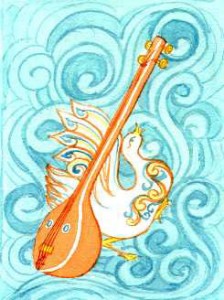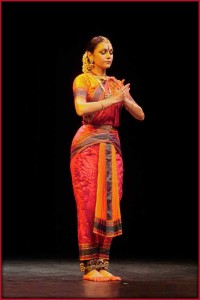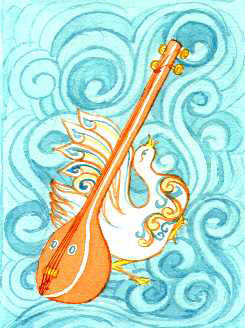by Anupama Krishnakumar
[box] Subadhra turns to classical music to chase away the monotony that has gripped her life. In the process, she brings meaning to the lives of people close to her. Here’s a story by Anupama Krishnakumar that is sure to leave you savouring the musical ambience that it brings. [/box]I was visiting the Srinivasans after nearly six years. This time it was not Tanjore like it had always been before. Six years had seen immense change in between. Periappa and Periamma had moved to Chidambaram only six months prior to my visit. Twists and turns had routed themselves into our lives, quite in unsought ways.
Working as a project manager for a top notch IT firm definitely presents a picture of great well-being both financially and personally. But, what it costs to get to that picture is a sad story. As much aggressive as one can get with facing tough challenges, the human spirit of an ordinary individual (like me) does wear out and starts seeking succour from soothing elements. As in the case of many of us, I have by all means turned to one preferred saviour all these years – Music.
I ought to thank that one particular cassette that I dusted out of my broken cassette cupboard, one fine day. (One ought not to be surprised hearing about the dilapidated state of the poor cupboard and the cassettes within, given that everything is packed into CDs and Ipods these days). Music lovers would indeed agree if I said that we sometimes get a certain, sudden and powerful urge to listen to a particular song. It was a similar state of mind that drove me to the cupboard that day. I wanted to listen to the unmatchable legend, MS.
Small events often set the stage for larger ones, in the most unexpected ways. The mind that sought some relaxation directed my fingers to wind the tape to reach one of MS’s most beautiful renderings – Kurai Ondrum Illai, composed by Rajaji and sung in Ragamalika. As I closed my eyes, it felt like the magical voice was flooding my veins and was rushing up to my brain. Rewind, play – rewind, play – rewind, play. The more I heard the song, the more I wanted to demystify the magic behind that powerful art and the medium – her divine voice. How could it bring so much relief to a tired mind? What would it feel like to be the one, actually causing that change to a distressed soul?
It was then I decided to pack my bags. Amma was pleased to hear that I wanted to cut a week long trip to Chidambaram. “May be, it would be a welcome break for Periamma as well,” she held. “I just hope so,” I shrugged.
When I landed in Chidambaram, Periappa demonstrated little more of life compared to his wife. Revathi Srinivasan seemed a picture that would evoke pity even in the most cruel of minds. She appeared to have lost her direction in life. Would I in some way help her in finding her bearings again? Would I be able to add some music to her life? Tough call. But, it was definitely worth a try.
My cousin, and their only son, Raghu’s photograph, heavily framed, hung from the wall facing the entrance. A huge garland accompanied it. Fate had really played with their lives. Working in the U.S., Raghu had died in a horrifying road accident, a year before, just a few weeks before his engagement.
Periamma burst into tears, as I stood rooted to the spot, staring at the bright, young face that now belonged to a passive photograph and not to a being brimming with life. I was left with nothing to do but wonder about the triviality of human life.
Periamma soon disappeared into the kitchen to fetch something to eat, when Periappa began to talk in a low voice. “She has never been the same, since that day.”
I nodded.
“She hasn’t touched the Thanpura in ages,” I followed his eyes to land them on the Thanpura that lay aimlessly in a corner. I couldn’t help being reminde d of a picture from older, happier days – Periamma sitting in the balcony, when the tender rays of the morning sun touched down the earth. Her fingers would gently rub the strings of the gracefully slanted Thanpura. She would rest her head against the instrument, eyes closed as her mouth rendered soulful music. The notes Sa Pa Sa from the Thanpura and her voice would flood the room.
d of a picture from older, happier days – Periamma sitting in the balcony, when the tender rays of the morning sun touched down the earth. Her fingers would gently rub the strings of the gracefully slanted Thanpura. She would rest her head against the instrument, eyes closed as her mouth rendered soulful music. The notes Sa Pa Sa from the Thanpura and her voice would flood the room.
When Periamma came back from the kitchen with a cup of coffee, I prepared myself to put forth my request.
“Periamma,” I said, “I want to get back to learning music again. Would you initiate me into it?”
As expected, there was silence. I decided it was best not to press further.
I had learnt Carnatic music (with not so much zeal then, I must admit) till when I was in college. But I, despite the possibility of avoiding such a move, reasoned the importance of shifting priorities and jumped completely into my career. Since then, singing became a forgotten story. Recent happenings at work (and that being no room for an escape into peace), however, rekindled my interests towards learning music.
A whole day passed without even a mention of the word music. The Srinivasans listened as I told them stories of how things were so different, the moment you stepped into your work place.
The following morning, I stood before the Thanpura, admiring its fineness. How could four strings depict the base of an entire system of art? I plucked them, one after the other. The Thanpura had obviously tuned out of Sruti, owing to its long time unused state. The urge to sing was getting on me and I decided to go ahead.
I sat down in the huge puja room and began, quite hesitantly, with one of my favourites – Krishna Nee Beganey, in Yaman Kalyani. Jitters, in the voice, with the words, the Sruti, Sangathi and what not!
“So, how long has it been? Your voice just doesn’t seem to be cooperating,” I almost jumped, when I heard Periamma’s voice behind. Better still, she was standing with the Thanpura in her hand.
I simpered, like an idiot. “Quite a sad picture, I know,” I said.
Periamma was meanwhile busy aligning the strings to Sruti. In a moment, she was sitting next to me. She stared vacantly into the space ahead and at the framed picture of the Musical Trinity in the puja room.
She positioned the Thanpura in its traditional way and her fingers began their journeys towards Divinity. She threw a glance at me and began an Alaap in Yaman Kalyani. The mellifluous voice that emanated from her slowly spread its wings to glide all over the room. Suddenly, it felt like some force was sponging out all pressures and fears from within.
While I sat engrossed in the absorbing raga, Periamma slid smoothly into the Pallavi of Krishna Nee Beganey. Had it been a year since she sang? I couldn’t believe it. Periappa didn’t stir out of his seat and when we met after the song, we had tears in our eyes.
The theory of music has always remained a great passion for me. How could a swara change the very nature of a raga that it starts sounding totally different? And on the other hand, it’s amazing how beautifully we can slide from Paavana Guru to Sreenivasa Thiruvengada almost effortlessly, just because they are both sung in the raga Hamsanandhi!
That evening Periamma mentioned about a young woman next door. If there was one thing that she ever spoke of since my arrival, it was her – Nandini Parthasarathy.
“A young woman, may be in her late twenties, a Bharatanatyam dancer,” she briefed.
The next evening, I was knocking at Nandini’s door. A woman with a striking face welcomed me in.
“Hello, I am Subadhra, your neighbour’s niece,” I introduced myself.
She smiled, “Come in.”
“So you,” she paused, “were responsible for the beautiful voice I got to hear today morning,” she asked, inquiringly.
“Well, yes and no,” I said, “Yes, because I was the one who kind of got the voice to sing, and no, because, I wasn’t the one who sang!”
She laughed, and yes, very cutely that I couldn’t help smiling.
“I had the privilege to listen to her today morning,” I said.
“So did I,” she added.
That particular morning had begun with me wanting to learn a new song.
“Thaye Yashoda,” proposed Periappa.
I cajoled a reluctant Periamma to teach me the song. After a long session of please please please – she began.
“Thaye Yashoda undhan aayar kula thudhitha..”
“Hmm..sing after me,” she said.
But Thodi had already left me enthralled, for me to even open my mouth. I realized there is sometimes so much pleasure in line, when you remain a complete rasika.
“Periamma, I would love to be a listener for this week,” and she smiled, for the first time since I had arrived.
“Maayan Gopalakrishnan seyyum jaalathai keladi,
Thaaye Yashoda..”
Nandini told me she was there to attend the annual Natiya Thiruvizha (Dance Festival) and was staying with her uncle’s family. A student of Kalakshetra, she had been learning dance from a young age of four. She had chosen Chidambaram to pursue primary research related to a Natiya Natakam, a dance drama she was choreographing.
Nandini fascinated me, for the fact that she belonged to my generation and the life that she had chosen to live was so different from mine.
“Are you married?” she asked me suddenly.
“Yes,” I replied, taken by surprise, “fairly recently, why?”
“No, I just asked,” she replied.
“Are you?” I posed the question back to her.
“No. I don’t intend to either.”
“Really, but why?” I raised my eyebrows.
She wanted to devote herself to the art, she said. She was married to dance, so she believed. I smiled back, for I had no words.
I had hesitantly asked Nandini whether she would mind me dropping into her place, when I felt like. “It’s only for a few more days,” I assured her as she watched me with laughing eyes. “You silly girl,” I felt I saw her eyes talking thus. “Come on, Subadhra, anytime.”
“Thanks,” I mumbled.
I was back at her place the next afternoon.
“I want to ask you for something today,” I said, walking in with a request in hand.
“And, what’s that?”
“Can I get to see your dancing prowess today?” I put forth.
She began laughing again. “Sure, why not?”
 She switched on the tape and began a performance, a stellar one at that, for “Enna thavam Sedhanai, Yashoda..”
She switched on the tape and began a performance, a stellar one at that, for “Enna thavam Sedhanai, Yashoda..”
The bhavana on her face left me speechless and her mudras, were poetry in themselves. A pleasure in addressing Yashoda, mixed with envy for the lucky mother, was so absorbingly apparent in her eyes.
I was fascinated, simply I was. For, what is it but providence that had made me listen to the same song being sung by Periamma in the morning?
When I had watched her sing, I was a witness to what one would call matchless involvement. She had closed her eyes and her fingers moved over the Thanpura carelessly but precisely and I knew she was oblivious to what was going on around her. She was no longer singing for Subadhra, or for her husband or for her own self. It was for the Master.
“Uralil katti, vai pothi, kenja vaithai kannanai..” she sang and in her rendering of “kenja..” I saw the Lord begging His mother to free Him. May be she saw it too for the voice throbbed with utmost passion.
And here I was, watching Nandini summoning the same emotions with such ardent reverence. I was struck by the devotion of two performing women towards their respective arts which they considered no different from the ultimate Master. In doing so, they were also helping spectators, rasikas like me, see what they saw.
In Nandini’s words, “Dance (or any art), is a constant effort to feel one with the Divine. It no longer remains a performance to please the audience, but for the Lord Himself,” she said.
Wasn’t MS great because of this?
I told Nandini that I was curious to know about her present project – the Natya Natakam.
“That, “she began, “is an effort to touch upon the Navarasas – the nine human emotions.”
“I intend to divide the play into nine parts, one belonging to each of the rasas – ranging from Karuna (compassion) to Hasya (Humour) to Shanta (Peace). Each part will exclusively deal with portraying each of these emotions to their greatest depths.”
“How’s it coming along?” I asked her.
“Quite fine, but I am presently focusing on getting to know ragas that best go with a particular emotion and getting to may be composing pieces for the dance, or selecting songs from that particular raga,” she explained.
“For example,” I continued.
“Hmm..for example, let’s take the Karuna rasa,” she paused, “a raga like Sahana would beautifully convey the emotion.”
“I think I can help,” I said. “You can work together with my aunt.”
“But we got to speak to her first,” I added.
I got Periamma to agree to help Nandini. “Please..she is my friend,” I told her.
“Ok, ok, get her home,” said Periamma.
Periappa was thrilled. His wife was getting better.
The day I was leaving, I proposed a joint performance from Revathi Srinivasan and Nandini Parthasarathy. Nandini almost jumped to say a Yes. Periamma, was her usual composed self – but she said yes too.
I took the privilege of selecting the song. “Vandanamu Raghunandana, in Sahana,” I proposed eagerly.
By the end of the performance I was left with a wonderful fulfilment. I had landed with a different intention and it never went the way I had planned. Well, all that mattered was I made someone happy and in the end, I was happy myself.
It so happens that our ways forward in our lives is determined by one’s own perception of events that occur around us or essentially what meanings we can derive out of them. We could compare this to watching a cloud. When only plainly stares at it, it would probably make no sense. But, take an effort and watch it closely and soon, we start seeing meaningful shapes. Events are like passing clouds and what we make out of them is like observing some sense from those obscure shapes. Reasoning sometime helps.
My trip helped me get some perspective with my life. There is so much to do with it. May be I had to get serious about some music classes.
I hope Periamma found a direction too. I hope she found some meaning to her life from that string of small events, in a week. I hope there is now, a ray of hope.
Pic : dancer : dalbera – http://www.flickr.com/photos/dalbera/
Anupama Krishnakumar loves Physics and English and sort of managed to get degrees in both – studying Engineering and then Journalism. Yet, as she discovered a few years ago, it is the written word that delights her soul and so here she is, doing what she loves to do – spinning tales for her small audience and for her little son, bringing together a lovely team of creative people and spearheading Spark. She loves books, music, notebooks and colour pens and truly admires simplicity in anything! Tomatoes send her into a delightful tizzy, be it in soup or rasam or ketchup or atop a pizza!
[button link=”https://sparkthemagazine.com/wp-content/uploads/2011/10/spark-oct2011.pdf” color=”orange” newwindow=”yes”] Click here to download the October 2011 issue as a PDF![/button] [button link=”http://issuu.com/sparkeditor/docs/spark-oct2011?mode=embed&layout=http%3A%2F%2Fskin.issuu.com%2Fv%2Fcolor%2Flayout.xml&backgroundColor=000000&showFlipBtn=true” color=”red” newwindow=”yes”] Click here to flip and read the issue like a magazine[/button]
[facebook]share[/facebook] [retweet]tweet[/retweet]








Dear Anu,
You have managed to let your goal stand out more than the medium used to express it. The goal of helping the other as the means to help yourself..the very core principle of Indian culture. Enjoyed reading. Great work!